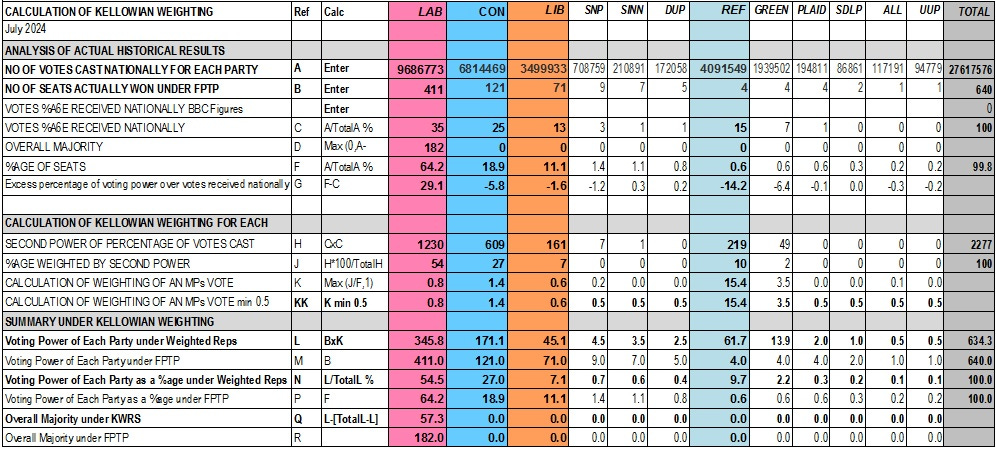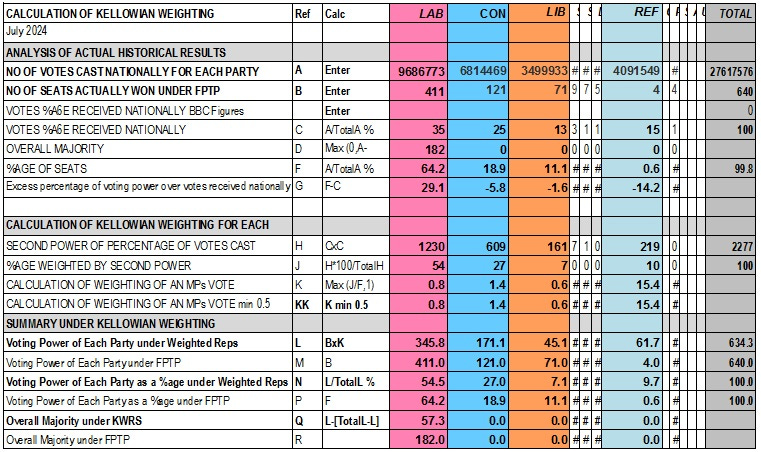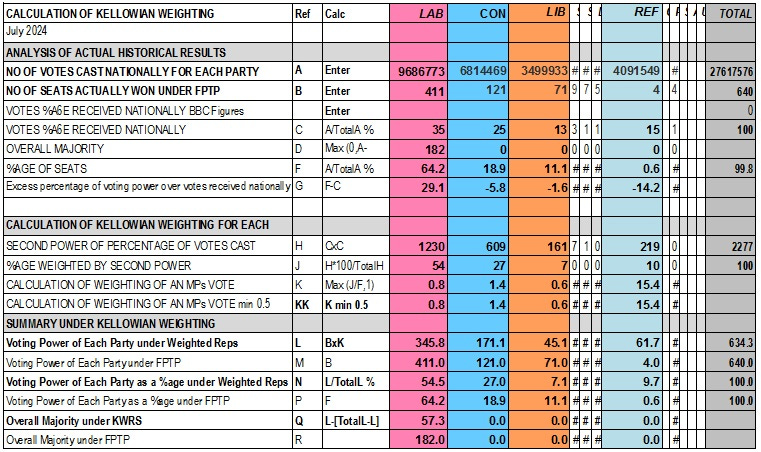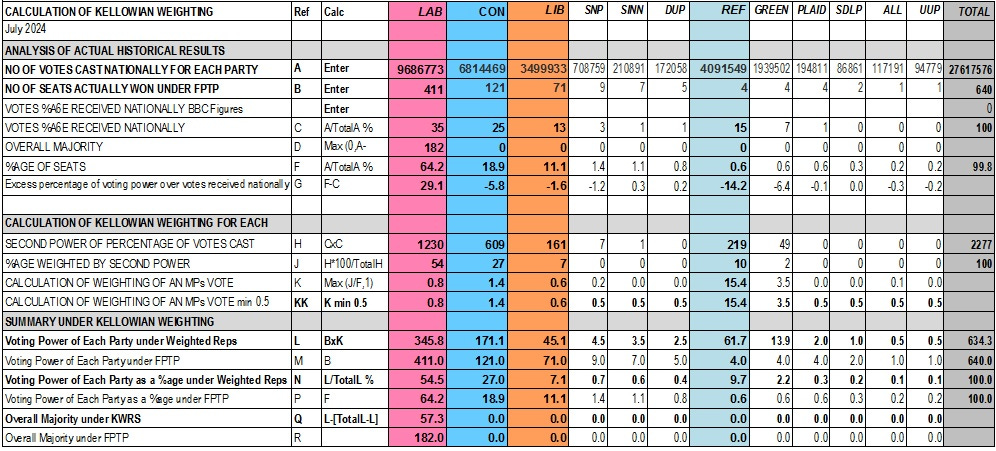THE "WEIGHTED REPS" NEW ELECTORAL SYSTEM
CPN205 How the July 2024 UK General Election would have been fairer
Peter Kellow
1. WHAT IS DEMOCRACY?
There are doubtless many reasons why a large number of people are disillusioned with the democratic process. That none of the three main parties have any positive ideas to address the real problems we face and that all seem to say much the same thing in the race to occupy the hallowed middle ground must be a large part of it.
But the electoral system itself must surely also play a large part in inducing voter apathy and despair. It is in part responsible for the sense that the political establishment need not respond to people’s real concerns.
The electoral system we use, known as first-past-the-post (FPTP) has major faults. But then so do the usual alternatives that are put forward. These have until now always been some form of proportional representation (PR). In PR systems an attempt is made to make the representation of political parties in the elected assembly reflect national voting patterns. This is described by its advocates as more “democratic”.
But what do we mean by “democratic” in this instance? Historically there is no justification for equating proportional representation with democracy. Democracy has usually meant the winner of an election taking all the power and this is certainly how democracy has traditionally worked in Britain. Democracy is a contest with winners and losers,
2. PROPORTIONAL REPRESENTATION DOES NOT WORK
The proponent of PR might have a stronger case if it were not for one concept that has, right from its beginnings in Ancient Greece, been intrinsic to democracy: this is rotation.
If we were electing a government once and for all, for all time, then PR might make a kind of sense for it would mean that all parties big and small would have at least some kind of say in government. But this is not the case. We have rotation. Election to office is for a fixed term. Then we elect all over again
If you look at the representation at any one moment you could say that those parties that lost the last election have no representation – or relatively very little. After the 2010 election Labour had in effect almost no say in government, but if, however, you look at the period of, say, from the second world war until now they have enjoyed considerable power.
The practice of rotation does a lot to dismiss the case for PR.
The evidence is that the British people do not want PR. Let us not forget we had a nationwide referendum on the matter. The LibDems forced a referendum on a type of PR, Advantage Voting (AV), on the British people in May 2011, as a result of a deal with their then coalition partners the Tories
PR suffers from grave fundamental defects. But so does the alternative of FPTP. This is why I have devised a new electoral system called the Kellowian Electoral System of Weighted Representations, or “weighted reps” for short. Weighted reps, I believe, overcomes all the faults of both PR and FPTP, and delivers a system that will excite and interest the voters and promote a healthy democracy.
3. FAULTS WITH PR AND FPTP
Before explaining how it works let us set out these faults of the existing systems. These have been well rehearsed many times, but let us remind ourselves of what they are. There are three in each case
The arguments against the first-past-the-post system are:
1. Many voters in ‘safe’ seats are effectively disenfranchised as their vote will never make any difference to the outcome
2. It is ‘undemocratic’ as one party can obtain power with a low percentage of votes. Matters are even worse when the turnout is low which it usually is, these days – about 60% in the July 2024 general election
3. It is difficult for new parties to make headway in spite of polling a good percentage of votes nationally
The arguments against proportional representation systems are:
1. They result in weak governments with frequent coalitions and minority parties holding the key to forming governments
2. They allow minority parties who may be extremist to gain representation
3. PR systems, of whatever type, always do away with representation of a constituent by a single person. Thus any given MP can evade responsibility for looking after the people how voted for him or her. MPs no longer have “constituents” as such. Constituents have no one person to turn to,
All of these arguments against both systems are entirely valid.
4. PR USED FOR MEP ELECTIONS
The electoral system I propose is not difficult to understand in principle and is a million miles away from the complexity of a PR system that we used to use in Britain for MEP elections. It is worth just noting the rules of this by way of comparison. These officially are described as follows:
In a given region the allocated seats are awarded using a quota system. The quota is the total number of votes received by a party or independent candidate divided by the number of seats already gained in that region +1.
So, for a party with no seats the number of votes received is divided by one, and so stays the same. If the party already has one seat then its number of votes is divided by two, if it has two seats it is divided by three, and so on.
This means that the more seats you have already won, the harder it is to gain extra seats, so the overall allocation of seats is more proportional to the number of votes received.
The first seat that a party wins goes to the first person on its list, the second seat to the second person, and so on, until the party has either not won any more seats or has run out of names on its list. An independent candidate is treated as though he or she were a party with only one name on its list.
Well, I doubt whether you got past the first sentence of that gobbledygook. But I repeat - that is a system that we have had in this country. And, no, it was not cooked up in Brussels. It is entirely a home grown invention. Other countries use other systems.
5. KELLOWIAN WEIGHTED REPS
The Kellowian Weighted Reps system answers all of the problems cited of PR and FPTP, all of them. Too good to be true? Well, let’s see how it works.
The basic process is as follows
The members of the assembly are elected by a first-past-the-post system exactly as we have now for our House of Commons.
The difference arises once the MPs arrive in the Commons for each member has a vote “weighted” according to a calculation based on the overall national votes for their party. So if the weighting for a members of a party is, say, 1.2 (one-point-two) and in a debate ten members of that party vote their vote counts as 10 x 1.2 = 12.
This weighting is decidedly NOT to give the party a voting strength proportional to its share of the votes cast for that would simply introduce PR with all its evils.
It is decided by a simple transparent mathematical method that achieves the objectives of:making
every vote count
achieving stable government
making it easier for new parties to gain MPs
preserving the position of independents
disallowing extremist minority parties.
How this works I describe below
So as far as the voter is concerned the process of voting is exactly as now. What is different is the fact that, because overall national voting is taken into account in respect of your MP, there is not a single vote cast that is wasted.
So although the process of voting is the same, the effect of the votes will be quite different from the present system. Voters will quickly realise this and use their vote accordingly. It will mean above all that they will be much more inclined to vote for exactly the party they favour. Tactical voting will not be eliminated but it will be much reduced.
And perhaps more importantly voters will vote for they will know that every single vote, for any but the very small parties, in whatever constituency will affect the outcome in parliament
The simplicity of the system is much in its favour. Admittedly it is just slightly more complicated than FPTP, but then the latter is brutal and unjust in its simplicity.
The description of the Kellowian system above is all that any voter really needs to know to participate fully in it. The way it responds to voter intentions will be something people will see in practice through use and so the full technicalities of it do not need to be understood for its benefits to be fully delivered.
To calculate the Kellowian weighting for each party the election results are entered into a simple spreadsheet. All we need are the number of seats that each party obtained, as in Row A below, and the national percentages each party obtained, Row B.
So we need just two figures for each party. The spreadsheet does the rest of the work.
6. WEIGHTED REPS APPLIED TO THE GENERAL ELECTION OF JULY 2024
For the July 2024 general election the spreadsheet looks like this. To be complete this needs to be updated to include all the small parties, but this approximation will do for our present purposes
Table 1.
This may appear a little small so here is a version where the smaller parties are not shown. I will come back to the question of the smaller parties and independents
Table 2.
The column, Calculation, indicates rows where data must in entered with the word, Enter. All we need is the number of votes each party obtained nationally and the number of seats they gained on the present FPTP system. The spreadsheet does the rest
Row C gives us the percentage of votes each party received nationally. The total in the column on the right must be 100% of course. This performance of a party nationally is what we will use to adjust the “voting power” of each MP, and so of their party
Row F shows the percentage of seats each party has as an actual figure. Now if we compare row C with row F, we are comparing the number of votes nationally with the number of seats for each party
6.1 The Main Parties Under Weighted Reps
So in the example of Labour they have 64% of the seats but they only gained 35% of the votes nationally. This is obviously a vast discrepancy.
This is blatantly unfair and means that the Commons does not reflect the national voting. Labour could be said to enjoy far more power in government than it deserves
To repeat the weighted reps system leaves every MP in the seat to which they were elected and adds no additional “MPs without seats” as some PR systems do. The different is that when they vote in the motions in the Commons their vote does not count as one but is weighted in a calculation based on the number of votes their party obtained nationally
Now here is the clever bit. It would be easy to weight the votes to effectively deliver a PR system, but for the reasons explained PR systems do not work
I have found by experimenting on the results of all UK general elections since 1945 that a simple and effective weighting can be achieved by using the square or “second power” of the percentage of votes cast.
The advantages of this is best explained with an example and here I will use the July 2024 election
Table 2.
Row J shows the percentages adjusted by the second power and row K gives the weighting for the MPs of each party which is obtained by dividing row J by row F
So for instance each Labour MP has a weighted vote of 0.8. OK, they might not like it! But this reflects the massively unfair result as it stands with the simplistic FPTP system
By contrast each Tory MP has a weighting of 1.4 and this reflects likewise the fact that they are “cheated” by FPTP
Rows N and P compare the percentage of each party’s voting power under weighted reps and under the existing FPTP. Labour has a reduced voting power whereas the Tories have a greater voting power
However, Labour maintains its overall majority as row Q shows and this is fair given the number of votes it received nationally. Row R shows the existing overall majority and this is reduced. Again, this is fair.
6.2 The Reform Party Under Weighted Reps
Now let us consider the effect of weighted reps on the Reform Party. Row C records that it received 15% of the votes nationally – a staggering performance for a new party – but row F shows it only has 6% of the seats in parliament. This is blatantly enormously unfair and we can say undemocratic as the intentions of voters are very far from being reflected in parliament
Table 2.
However, the weighted reps system comes to the rescue by awarding each of the four Reform MPs a big weighting of 15.4, so each MPs vote in the commons counts as more that 15. But this is not enough to make the Reform Party’s voting power to be proportional to their national vote. That would give us PR by the back door and this we decidedly do not want
If you refer to row N you will see that Reforms voting power is at 9.7% in parliament whereas they received 15% of the national vote. Is this unfair? No it is not for the whole purpose of the weighting is to avoid PR in any guise.
However, this illustrates how weighted reps gives the chance for small parties to enter the race
6.3 The LibDems Under Weighted Reps
Turning to the Liberals we can see that the effect of weighed reps is quite the opposite of what we saw in the case of Reform
They gained 71 seats on a national vote of 13%, whereas Reform got 4 seats on a national vote of 15%. This is clearly massively unfair. It results from the arbitrary way in which FPTP works.
The LibDems would not be please to see that their weighting under weighted reps would be 0.6, but this is only fair.
Here it should be emphasised that weighted reps by using the second power for its calculations does not overdeliver to the smaller parties and this is an advantage to ensure stable government. The main parties stay the main parties, as it should be
6.4 Small Parties and Independents
This has covered the new system for any party of appreciable size, but what about small parties or independents that get just one MP.
The calculation of weighted reps according to the second power mathematically can deliver weighting that is close to zero for a single seat party. This is not acceptable and so as Table 1 shows the weighting cannot be less than 0.5
So instead of having a single vote, an MP with a small party or no party has half a vote
Table 1.
They may like to complain about this but it is fair as it reflects their national showing. And it should not be forgotten that being an MP is not just about voting, which actually few of them ever do, it is also about having the right to address parliament and benefit from the platform this gives, not to mention service to their constituents
7. GREATER VOTER PARTICIPATION
But in viewing these historical results, it cannot be stressed too strongly that under the Kellowian system, voting would be different.
So although the process of voting is the same, the effect of the votes will be quite different from the present system. Voters will quickly realise this and use their vote accordingly. It will mean above all that they will be much more inclined to vote for exactly the party they favour. Tactical voting will not be eliminated but it will be much reduced.
And perhaps more importantly voters will turn out to vote, for they will know that every single vote, for any but the very small parties, in whatever constituency, will affect the outcome in parliament,
And just as important, because every vote cast has an effect on the outcome in parliament, voter turnout will increase enormously.
The benefits of the Kellowian system for our democracy cannot be overstated.








Argument 3. against PR is simply not true if done correctly, like in Germany. Doing it that way also renders your complicated solution obsolete.
Interesting Idea. Democracy requires compromise and this system still encourages the voters that they can have their ideal. It would be interesting to compare this with Instant Run Off system. Voters need to
Understand number and counting may take longer but voters will practice compromise and the elected candidate is acceptable to majority of voters.